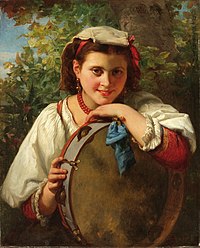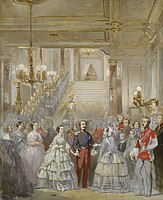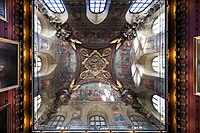| Charles Louis Müller | |
|---|---|
 Charles Müller by Étienne Carjat (between 1865 and 1870), Paris, BnF Charles Müller by Étienne Carjat (between 1865 and 1870), Paris, BnF | |
| Born | 28 December 1815 Paris |
| Died | 9 January 1892 8th arrondissement of Paris |
| Occupation | Painter |
| Awards | |

Charles Louis Müller (also known as Müller de Paris) (Paris 22 December 1815 – 10 January 1892 Paris) was a French painter.
Biography
He was the pupil of Léon Cogniet, Baron Gros and others in the École des Beaux-Arts. In 1837 he exhibited his first picture, Christmas Morning. From 1850 to 1853 he directed the manufactory of Gobelin tapestries. In 1864 he became a member of the Académie des Beaux-Arts of the Institut de France, succeeding Jean-Hippolyte Flandrin.
Works
He was a fecund producer of historic pictures and portraits. Among his works are Heliogabalus (1841), Primavera (1846), Haydée (1848), Lady Macbeth, and his masterpiece, Calling Out the Last Victims of the Reign of Terror at the Prison of Saint-Lazare (Appel des dernières victimes de la Terreur dans la prison de Saint-Lazare), with portraits of the most illustrious victims). Also notable are Vive l'Empereur, based on a poem by Méry about an episode in the battle before Paris, March 30, 1814 (1855), Marie Antoinette (1857), A Mass During the Reign of Terror (1863), Desdemona (1868), Lanjuinais at the Tribune (1869), The Madness of King Lear (1875), Charlotte Corday in Prison (1875), Mater Dolorosa (1877), The Martyrdom of St. Bartholomew and The Massacre of the Innocents.
He executed frescoes for the Salle d'État and the Galerie d'Apollon in the Louvre, and for the ceiling of the Salon Denon.
Gallery (chronological)
-
 Calling Out the Last Victims of the Terror at Saint Lazare Prison on the 7-9 Thermidor, Year II (1850), Musée de la Révolution française
Calling Out the Last Victims of the Terror at Saint Lazare Prison on the 7-9 Thermidor, Year II (1850), Musée de la Révolution française
-
The Madness of Haydée, scene from The Count of Monte Cristo (1848)
-
 Arrival of the Queen of England at the Palace of Saint Cloud (1855)
Arrival of the Queen of England at the Palace of Saint Cloud (1855)
-
 Ceiling of the Salon Denon with frescoes by Müller (1863–1866)
Ceiling of the Salon Denon with frescoes by Müller (1863–1866)
-
 The Tribunal of the National Convention (1868)
The Tribunal of the National Convention (1868)
-
 Charlotte Corday in Prison (1875), vintage postcard of the painting of unknown location
Charlotte Corday in Prison (1875), vintage postcard of the painting of unknown location
-
 The Betrothed (by 1892)
The Betrothed (by 1892)
References
- In the Lille Museum.
- The last two are in the Luxembourg.
- John Jacob Astor IV had a replica of the last in his collection.
- "Appel des dernières victimes de la Terreur à la prison Saint Lazare". Réunion du Musées Nationaux - Grand Palais (in French). Retrieved 12 July 2014.
- ^ At one time this was the most copied painting in the Corcoran Gallery of Washington, D.C., which deaccessioned the painting in 1979; see Sarah Cash, editor, Corcoran Gallery of Art: American paintings to 1945, 2011, p. 43. While many copies exist, the current location of Müller's original painting is unknown; see Wierich, Jochen, The domestication of history in American art: 1848-1876, dissertation, College of William & Mary—Arts & Sciences, 1998, p. 108.
- According to French Misplaced Pages (visited 22 March 2013), these works were all destroyed by fire, and the Mona Lisa resides in that location now.
- According to French Misplaced Pages (visited 12 July 2014), painted between 1863 and 1866, representing four important French sovereigns prior to Napoleon III (also, see External Links for direct link to Louvre description).
Sources
- This article incorporates text from a publication now in the public domain: Rines, George Edwin, ed. (1920). "Müller, Charles Louis" . Encyclopedia Americana.
- Gilman, D. C.; Peck, H. T.; Colby, F. M., eds. (1905). "Müller, Charles Louis" . New International Encyclopedia (1st ed.). New York: Dodd, Mead.
- Ripley, George; Dana, Charles A., eds. (1879). "Müller, Charles Louis" . The American Cyclopædia.
External links
- Details regarding Müller's Charlotte Corday in Prison at the Smithsonian Pre-1877 Art Exhibition Catalogue Index.
- "Charles-Louis MÜLLER". cartelfr.louvre.fr. Retrieved 16 May 2011. Decoration for the ceiling of the Denon room at the Louvre, commissioned in 1862, executed 1863–1866.